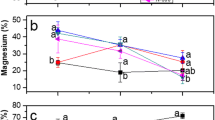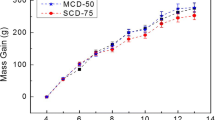Abstract
Silicon (Si) is important for the growth and development of bone and connective tissues. This study aimed to evaluate the effect of Si supplementation on the balance of calcium (Ca), Si, magnesium (Mg), and bone status in growing female rats fed diets with different Ca levels. Sixty 6-week-old female Wistar rats were divided into 6 groups and fed diets with different levels of Ca (0.1, 0.5, 1.5%) and Si (5, 500 ppm) for 10 weeks. Experimental groups were as follows: Low-Ca group (LCa; 0.1% Ca), Low-Ca with Si supplementation group (LCaSi), adequate-Ca group (ACa; 0.5% Ca), adequate-Ca with Si supplementation group (ACaSi), high-Ca group (HCa; 1.5% Ca), and high-Ca with Si supplementation group (HCaSi). Si retention significantly increased by Si supplementation and significantly decreased by high-Ca diet (1.5%). Mg retention significantly decreased by high-Ca diet. Serum Ca and Si contents were not significantly different among the 6 groups. Low-Ca diet significantly increased serum osteoclain and C-telopeptide cross-link of type 1 collagen (CTx) levels, and Si supplementation significantly decreased CTx levels in the low-Ca diet group. Bone mineral density was significantly increased along with Ca increase in the diet, but was decreased by Si supplementation in the high-Ca diet. Rats in the adequate-Ca diet group had a significant increase in strength of tibia after Si supplementation. These findings indicate that the effect of Si supplementation on bone metabolism may differ according to the Ca-intake level in growing females. Although further research is needed, when supplementing Si to improve bone health in growing females, Ca-intake level should be considered.
Similar content being viewed by others
References
Eisman JA, Kelly PJ, Morrison NA, Pocock NA, Yeoman R, Birmingham J, Sambrook PN (1993) Peak bone mass and osteoporosis prevention. Osteoporos Int 3(S1):56–60
Prentica A (2004) Diet, nutrition and the prevention of osteoporosis. Public Health Nutr 7(1A):227–243
Korean Center for Disease Control and Prevention. Korea health statistics 2018: Korean national health and nutrition examination. Seoul: Ministry of Health and Welfare; 2017
Kim SH (2011) Survey on the patterns of fortified food consumption and intake of vitamins and minerals in fortified foods by elementary school and middle-school students in Korea. Korean J Food Cult 26(3):295–306
Kim MG, Kim YS, Kim YS, Lee SB, Ryu KS, Yoon MH, Lee JB (2014) A study on the content of minerals in fortified food. J Food Hyg Saf 29(2):99–104
Farsinejad-Marj M, Saneei P, Esmaillzadeh A (2016) Dietary magnesium intake, bone mineral density and risk of fracture: a systematic review and meta-analysis. Osteoporos Int 27(4):1389–1399
Lee KS, Jang JS, Lee DR, Kim YH, Nam GE, Han BD, Do Han K, Cho KH, Kim SM, Choi YS, Kim DH (2014) Serum ferritin levels are positively associated with bone mineral density in elderly Korean men: the 2008-2010 Korea National Health and Nutrition Examination Surveys. J Bone Miner Metab 2(6):683–690
Hyun TH, Barrett-Connor E, Milne DB (2004) Zinc intakes and plasma concentrations in men with osteoporosis: the Rancho Bernardo Study. Am J Clin Nutr 80(3):715–721
Rico H, Gómez-Raso N, Revilla M, Hernández ER, Seco C, Páez E, Crespo E (2000) Effects on bone loss of manganese alone or with copper supplement in ovariectomized rats. A morphometric and densitomeric study. Eur J Obstet Gynecol Reprod Biol 90(1):97–101
Oweis RR, Levy SM, Eichenberger-Gilmore JM, Warren JJ, Burns TL, Janz KF, Torner JC, Saha PK, Letuchy E (2018) Fluoride intake and cortical and trabecular bone characteristics in adolescents at age 17: a prospective cohort study. Community Dent Oral Epidemiol 46(6):527–534
Jugdaohsingh R, Tucker KL, Qiao N, Cupples LA, Kiel DP, Powell JJ (2004) Dietary silicon intake is positively associated with bone mineral density in men and premenopausal women of the Framingham offspring cohort. J Bone Miner Res 19(2):297–307
Saltman PD, Strause LG (1993) The role of trace minerals in osteoporosis. J Am Coll Nutr 12(4):384–389
Strause L, Saltman P, Smith KT, Bracker M, Andon MB (1994) Spinal bone loss in postmenopausal women supplemented with calcium and trace minerals. J Nutr 124(7):1060–1064
Nielsen FH (2014) Update on the possible nutritional importance of silicon. J Trace Elem Med Biol 28(4):379–382
Jugdaohsingh R, Anderson SH, Tucker KL, Elliott H, Kiel DP, Thompson RP, Powell JJ (2002) Dietary silicon intake and absorption. Am J Clin Nutr 75(5):887–893
Carlisle EM (1970) A relationship between silicon and calcium in bone formation. Fed Proc 29:565
Bae YJ, Kim JY, Choi MK, Chung YS, Kim MH (2008) Short-term administration of water-soluble silicon improves mineral density of the femur and tibia in ovariectomized rats. Biol Trace Elem Res 124(2):157–163
Rico H, Gallego JL, Hernandez ER, Villa LF, Sanchex-Atrio A, Seco C, Gervas JJ (2000) Effect of silicon supplement on osteopenia indced by ovariectomy in rats. Calcif Tissue Int 66(1):53–55
Calomme M, Geusens P, Demeester N, Behets GJ, D’Haese P, Sindambiwe JB, Van Hoof V, Berghe DV (2006) Partial prevention of long-term femoral bone loss in aged ovariectomized rats supplemented with choline-stabilized orthosilicic acid. Calcif Tissue Int 78(4):227–232
Kim MH, Bae YJ, Choi MK, Chung YS (2009) Silicon supplementation improves the bone mineral density of calcium-deficient ovariectomized rats by reducing bone resorption. Biol Trace Elem Res 128(3):239–247
Kim MH, Kim EJ, Jung JY, Choi MK (2014) Effect of water-soluble silicon supplementation on bone status and balance of calcium and magnesium in male mice. Biol Trace Elem Res 158(2):238–242
Kayongo-Male H, Julson JL (2008) Effects of high levels of dietary silicon on bone development of growing rats and turkeys fed semi-purified diets. Biol Trace Elem Res 123(1–3):191–201
Macdonald HM, Hardcastle AC, Jugdaohsingh R, Fraser WD, Reid DM, Powell JJ (2012) Dietary silicon interacts with oestrogen to influence bone health: evidence from the Aberdeen Prospective Osteoporosis Screening Study. Bone 50(3):681–687
Institute of Laboratory Animal Resources (1996) Guide for the care and use of laboratory animals. National Academies Press, Washington, DC
Breitman PL, Fonseca D, Cheung AM, Ward WE (2003) Isoflavones with supplemental calcium provide greater protection against the loss of bone mass and strength after ovariectomy compared to isoflavones alone. Bone 33(4):597–605
Calomme MR, Vanden Berghe DA (1997) Supplementation of calves with stabilized orthosilicic acid. Effect on the Si, Ca, Mg, and P concentrations in serum and the collagen concentration in skin and cartilage. Biol Trace Elem Res 56(2):153–165
Reffitt DM, Jugdaohsingh R, Thompson RP, Powell JJ (1999) Silicic acid: its astrointestinal uptake and urinary excretion in man and effects on aluminium excretion. J Inorg Biochem 76(2):141–147
Van Dyck K, Van Cauwenbergh R, Robberecht H, Deelstra H (1999) Bioavailability of silicon from food and food supplements. Fresenius J Anal Chem 363:541–544
Pruksa S, Siripinyanond A, Powell JJ, Jugdaohsingh R (2014) Silicon balance in human volunteers; a pilot study to establish the variance in silicon excretion versus intake. Nutr Metab 11(1):4
Kuo TR, Chen CH (2017) Bone biomarker for the clinical assessment of osteoporosis: recent developments and future perspectives. Biomark Res 5:18
Manhan LK, Escott-Stump S (2004) Krause’s food nutrition and diet therapy. In: Anderson JJB (ed) Nutrition and bone health, 11th edn. Elsevier, Philadelphia, USA, pp 645–647
Reffitt DM, Ogston N, Jugdaohsingh R, Cheung HF, Evans BA, Thompson RP, Powell JJ, Hampson GN (2003) Orthosilicic acid stimulates collagen type I synthesis and osteoblastic differentiation in human osteoblastic-like cells in vitro. Bone 32(2):127–135
Hott M, de Pollak C, Modrowski D, Marie PJ (1993) Short-term of organic silicon on trabecular bone in mature ovariectomized rats. Calcif Tissue Int 53(3):174–179
Wolf FI, Cittadini A (2003) Chemistry and biochemistry of magnesium. Mol Asp Med 24(1–3):3–9
Rude RK, Gruber HE (2004) Magnesium deficiency and osteoporosis: animal and human observations. J Nutr Biochem 15(12):710–716
Toba Y, Masuyama R, Kato K, Takada Y, Aoe S, Suzuki K (1999) Effects of diet magnesium level on calcium absorption in growing male rats. Nutr Res 19(5):783–793
Abraham GE, Grewal H (1990) A total dietary program emphasizing magnesium instead of calcium. Effect on the mineral density of calcaneous bone in postmenopausal women on hormonal therapy. J Reprod Med 35(5):503–507
Stendig-Lindberg G, Tepper R, Leichter I (1993) Trabecular bone density in a two-year controlled trial of peroral magnesium in osteoporosis. Magnes Res 6(2):155–163
Schaafsma A, de Vries PJ, Saris WH (2001) Delay of natural bone loss by higher intakes of specific minerals and vitamins. Crit Rev Food Sci Nutr 41(4):225–249
Flynn A (2003) The role of dietary calcium in bone health. Proc Nutr Soc 62(4):851–858
Alcock N, Macintyre I (1962) Inter-relation of calcium and magnesium absorption. Clin Sci 22:185–193
Hendrix ZJ, Alcock NW, Archibald RM (1963) Competition between calcium, strontium, and magnesium for absorption in the iosolated rat intestine. Clin Chem 12:734–744
Funding
“This work was supported by the Korea Research Foundation Grant funded by the Korean Government (MOEHRD)” (KRF-2006-331-C00315).
Author information
Authors and Affiliations
Corresponding author
Ethics declarations
Conflict of Interest
The authors declare that there is no conflict of interest.
Additional information
Publisher’s Note
Springer Nature remains neutral with regard to jurisdictional claims in published maps and institutional affiliations.
Rights and permissions
About this article
Cite this article
Kim, MH., Choi, MK. Effect of Silicon Supplementation in Diets with Different Calcium Levels on Balance of Calcium, Silicon and Magnesium, and Bone Status in Growing Female Rats. Biol Trace Elem Res 199, 258–266 (2021). https://doi.org/10.1007/s12011-020-02147-2
Received:
Accepted:
Published:
Issue Date:
DOI: https://doi.org/10.1007/s12011-020-02147-2




